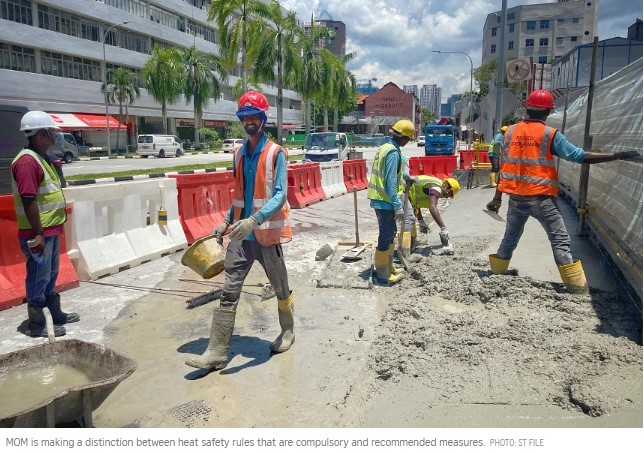MOM clarifies rules, recommendations to protect outdoor workers from heat stress
this is index.phpSINGAPORE – To make it easier for companies to protect employees working outdoors against intense heat, the Ministry of Manpower (MOM) has reworked current heat stress measures based on an existing advisory for the public.
The ministry is making a distinction between compulsory heat safety rules – such as having acclimatisation programmes and ensuring workers have roofed spaces to rest in – and recommended measures, such as rescheduling outdoor physical work to cooler parts of the day.
On Sept 6, MOM said it will conduct inspections at workplaces to ensure that the required measures under its reworked framework are implemented.
Worksites that breach these rules may be fined or given notices of non-compliance and stop-work orders.
This announcement follows inspections conducted from March to June – the hottest months of the year – which revealed that about one in three workplaces breached heat safety rules. Heat stress measures for outdoor workers were put in place in October 2023.
The reworked measures also give employers flexibility to adjust and implement measures based on their specific work settings, MOM said.
The advisory classifies heat stress levels as low, moderate or high, based on Wet Bulb Globe Temperature (WBGT) measurements, which indicate how hot the human body feels.
WBGT takes into account not only air temperature, but also humidity, wind speed and solar radiation. A WBGT reading below 31 deg C indicates low heat stress, while a reading of 33 deg C and above indicates high heat stress.
But for outdoor labourers, a 32 deg C WBGT reading is already classified as high heat stress. This applies to workers such as construction workers, outdoor cleaners, shipyard employees and delivery riders.
At that temperature, workers involved in heavy physical labour, such as shovelling and manual sawing, should be given at least 10 minutes to rest under shade every hour. If WBGT rises to 33 deg C, the recommendation is to increase the rest period to at least 15 minutes of rest per hour, MOM said.
Resting in ventilated, shaded areas moves workers away from heat sources, helps them rehydrate and allows their bodies to remove excess heat, according to an International Labour Organisation report in July.
Mr Lee Meng Shui, a senior project manager at Pal-Link Construction, said the reworked measures are easier to follow, making it clearer for worksites to know which rules they must implement.
The updated measures also identify vulnerable groups of workers whom employers should monitor closely, including elderly and pregnant employees, new workers from colder climates and those with chronic illnesses or a history of heat injury.
Of the 250 workplaces inspected between March and June, about 30 per cent were found to have breached heat safety rules.
At 78 worksites, employees were not provided with adequate rest breaks under shade for heavy physical work, nor were they put through heat acclimatisation programmes, among other contraventions.
Acclimatisation involves gradually exposing employees to Singapore’s heat and humidity, increasing the duration and intensity of outdoor work over a period of at least seven days.
In a Facebook post on Sept 6, NTUC assistant secretary-general Melvin Yong urged employers to ensure that their outdoor workers and supervisors undergo training to recognise the signs and symptoms of heat-related illnesses and appropriate first-aid measures.
“Older workers with pre-existing medical conditions may be at higher risk, as their thermoregulatory system may be compromised. Certain medications may also impair a person’s ability to respond to heat stress adequately,” Mr Yong said.
“As our annual average temperature continues to trend up, the likelihood of our workers encountering heat stress will only continue to grow,” he added.
More information about the revised measures can be found here: https://www.mom.gov.sg/heat-stress-measures-for-outdoor-work

About the author